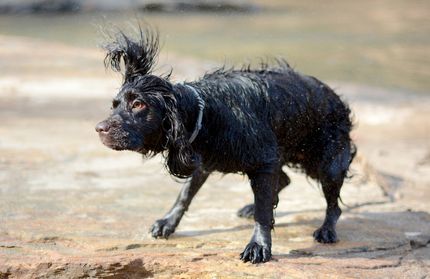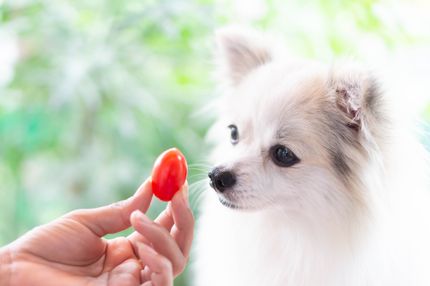Facts & Origin
Cavalier King Charles Spaniel and Miniature Pinscher in one
The King Pin is a relatively rare hybrid breed that is the result of crossing a Miniature Pinscher with a Cavalier King Charles Spaniel. The aim of this combination was to unite the alert, lively energy of the Miniature Pinscher with the gentle, people-oriented character of the Cavalier - in a compact, loving and active companion dog.
This designer mix probably originated in the USA or Great Britain in recent years as part of the general trend towards so-called "boutique mixes". Although the King Pin is not a recognized breed, it is becoming increasingly popular with people looking for a small dog with a big personality.
Criticism of the King Pin
As with many designer dogs, there is criticism of the King Pin - particularly with regard to breeding ethics, health and marketing. As it is not an officially recognized breed, there are no uniform standards for temperament, appearance and health requirements. This means that puppies from the same litter can differ significantly in both appearance and character.
A common problem with such mixes is uncontrolled breeding, where the health requirements of both parents are not taken into account. The Cavalier King Charles Spaniel, for example, has hereditary heart problems, while the Miniature Pinscher can have joint problems and behavioral problems.
In addition, animal welfare organizations criticize the fact that many of these dogs are sold as fashion dogs - with a focus on cute looks instead of species-appropriate husbandry or long-term responsibility.
Suitability of the King Pin
A well-bred King Pin can be an attentive, lively and at the same time cuddly companion dog. It is particularly well suited to active individuals, couples or families with older children who are keen to spend time with an intelligent, small dog with character.
The King Pin is usually playful, curious and alert, often with a slight tendency towards independence or stubbornness - depending on which breed traits dominate. At the same time, he can also show a tender, affectionate side and loves to be with his people.
He needs clear rules, loving consistency and regular mental and physical exercise. Due to his small size, he is well suited to living ind oors - however, his love of exercise should not be underestimated.
With early socialization and a reliable environment, the King Pin will develop into a loyal, active and charming little dog that brings a lot of zest for life and bonds closely with its people.
| Alternate Name | CKCS Miniature Pinscher Mix |
| Origin | England - Germany |
| Life expectancy | 9 - 15 years |
| Care requirements | low-maintenance |
| Activity level | average - average to high |
| FCI group | not recognised |
| AKC group | not recognised |
| KC group | not recognised |
More Cavalier King Charles Spaniel mixes
More Dwarf Pinscher mixes
Attitude, character and temperament of the breed
Possible character traits of the King Pin
The King Pin is usually a spirited, intelligent and affectionate little dog that likes to be active, but also enjoys being close to its owner. The mix of Miniature Pinscher and Cavalier King Charles Spaniel usually produces a bright, curious and people-friendly character.
They often inherit courage, independence and a watchful instinct from the Miniature Pinscher - qualities that make them an attentive little companion. The Cavalier, on the other hand, brings gentleness, affection and a playful, friendly nature. This combination makes for a dog that likes to be kept busy as well as enjoying quiet moments with the family.
As a rule, the King Pin is quick to learn, loves shared activities and is loyal, cuddly and lively when properly led. At the same time, depending on its genetic make-up, it can also be headstrong or territorial, which requires consistent but loving training.
Character
Usage
Possible diseases of the King Pin
As the King Pin is a mixed breed, health risks can be passed on from both parents. Responsible breeding with vet-certified parents is therefore particularly important.
Typical diseases that can occur in the King Pin:
Mitral valve insufficiency - a common heart disease in the Cavalier King Charles Spaniel
Patellar luxation - a dislocation of the kneecap, typical in small dogs
Eye diseases, e.g. cataracts or dry eyes
Dental problems, especially with narrow teeth in small jaws
Hip dysplasia or joint problems, as occasionally occur in the Miniature Pinscher
Behavioral sensitivity, such as a tendency to nervousness or overreaction to overstimulation
With good care, a high-quality diet, regular exercise and preventive veterinary care, many of these conditions can be managed well or detected at an early stage.
This is what a King Pin can look like
The external appearance of the King Pin can vary greatly, as it comes from two very different breeds. Most King Pins are small to medium-sized dogs with a shoulder height of 25 to 33 centimetres and a weight of 4 to 7 kilograms.
The build is usually slender but muscular, with an elegant, upright posture. The head shape often lies between the roundish face of the Cavalier and the somewhat narrower, more striking expression of the Miniature Pinscher. The ears are usually drooping or semi-erect, depending on the disposition.
The coat is usually short to medium length, can be smooth or slightly wavy and is usually soft to the touch. Grooming is usually uncomplicated, although regular brushing may be necessary for longer coats.
The coat colors vary: Combinations of black, brown, beige, red, white or tricolor patterns are typical, which can reflect both the rich colors of the Miniature Pinscher and the soft tones of the Cavalier.
Overall, the King Pin comes across as a small, lively and expressive companion that stands out with its mixture of elegance and energy - a real character dog in miniature format.
| Fur length | medium - short |
| Fur | flat coated |
| Ear shape | Floppy Ear - Standing Ears |
| Tail | fanned out - lang |
| Anatomy | - |
| Size ♀ | 25 - 33 cm |
| Weight ♀ | 4 - 8 kg |
| Size ♂ | 25 - 33 cm |
| Weight ♂ | 4 - 8 kg |
| Suitable For | Beginner, Children, Children |
Known Diseases
Kidney disease
Symptoms of kidney disease in dogs: increased urination (polyuria) increased water intake. Inflammation of the mucous membrane of the mouth. Loss of appetite
valvular insufficiency
Heart valve diseases in dogs are among the most common heart diseases. Most often it is an acquired change in a heart valve.
Mitral Valve Diseas (MVD)
Mitral valve disease in animals and dogs, respectively
Curly Coat Dry Eye
Eye disease in dogs.
Nervousness
Very often, unfortunately, small and thin breed suffering from permanent nervousness.
Permanent tremor
Persistent tremors can be very common in small breeds, and are often psychological.
FAQ
-
King Pins are usually small to medium sized, with most adult dogs weighing between 7-10 kg.
-
The life expectancy of these dogs is usually 12 to 15 years.
-
Yes, King Pins generally get on well with children, although they can be too small for very small children.
-
Health problems that have occurred in these dogs include heart problems, eye problems and hip dysplasia.
-
No, these dogs don't need much exercise, although they do enjoy going for walks and playing.





















